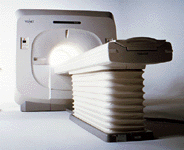 | Info
Sheets |
| | | | | | | | | | | | | | | | | | | | | | | | |
 | Out-
side |
| | | | |
|
| | | | | |  | Searchterm 'pulse sequences' was also found in the following services: | | | | |
|  |  |
| |
|
Spoiled gradient echo sequences use a spoiler gradient on the slice select axis during the end module to destroy any remaining transverse magnetization after the readout gradient, which is the case for short repetition times.
As a result, only z-magnetization remains during a subsequent excitation. This types of sequences use semi-random changes in the phase of radio frequency pulses to produce a spatially independent phase shift.
Companies use different acronyms to describe certain techniques.
Different terms for these gradient echo pulse sequences:
CE-FFE-T1 Contrast Enhanced Fast Field Echo with T1 Weighting,
GFE Gradient Field Echo,
FLASH Fast Low Angle Shot,
PS Partial Saturation,
RF spoiled FAST RF Spoiled Fourier Acquired Steady State Technique,
RSSARGE Radio Frequency Spoiled Steady State Acquisition Rewound Gradient Echo
S-GRE Spoiled Gradient Echo,
SHORT Short Repetition Techniques,
SPGR Spoiled Gradient Recalled (spoiled GRASS),
STAGE T1W T1 weighted Small Tip Angle Gradient Echo,
T1-FAST T1 weighted Fourier Acquired Steady State Technique,
T1-FFE T1 weighted Fast Field Echo.
In this context, 'contrast enhanced' refers to the pulse sequence, it does not mean enhancement with a contrast agent. | |  | | | | | | | | |  Further Reading: Further Reading: | News & More:
|
|
| |
|  | |  |  |  |
| |
|
( SPIO) Relatively new types of MRI contrast agents are superparamagnetic iron oxide-based colloids (median diameter greater than 50nm). These compounds consist of nonstoichiometric microcrystalline magnetite cores, which are coated with dextrans (in ferumoxide) or siloxanes (in ferumoxsil). After injection they accumulate in the reticuloendothelial system (RES) of the liver (Kupffer cells) and the spleen. At low doses circulating iron decreases the T1 time of blood, at higher doses predominates the T2* effect.
SPIO agents are much more effective in MR relaxation than paramagnetic agents. Since hepatic tumors either do not contain RES
cells or their activity is reduced, the contrast between liver and lesion is improved. Superparamagnetic iron oxides cause noticeable shorter T2 relaxation times with signal loss in the targeted tissue (e.g., liver and spleen) with all standard pulse sequences.
Magnetite, a mixture of FeO and Fe2O3, is one of the used iron oxides. FeO can be replaced by Fe3O4.
Use of these colloids as tissue specific contrast agents is now a well-established area of pharmaceutical development. Feridex®, Endorem™, GastroMARK®, Lumirem®, Sinerem®, Resovist® and more patents pending tell us that the last word in this area is not said.
Some remarkable points using SPIO:
•
A minimum delay of about 10 min. between injection (or infusion) and MR imaging, extends the examination time.
•
Cross-section flow void in narrow blood vessels may impede the differentiation from small liver lesions.
•
Aortic pulsation artifacts become more pronounced.
See also Superparamagnetism, Superparamagnetic Contrast Agents and Classifications, Characteristics, etc.. | |  | |
• View the DATABASE results for 'Superparamagnetic Iron Oxide' (32).
| | |
• View the NEWS results for 'Superparamagnetic Iron Oxide' (3).
| | | | |  Further Reading: Further Reading: | | Basics:
|
|
News & More:
| |
| |
|  | |  |  |  |
| |
|
| |  | |
• View the DATABASE results for 'Tip Angle' (5).
| | | | |  Further Reading: Further Reading: | Basics:
|
|
| |
|  |  | Searchterm 'pulse sequences' was also found in the following services: | | | | |
|  |  |
| |
|

From Toshiba America Medical Systems Inc.;
the Ultra™ system was developed to help healthcare providers be more competitive by delivering greater patient comfort and a broad range of clinical capabilities, says Anita Bowler, product manager, MRI Business Unit, Toshiba America Medical Systems Inc With its unique, powerful gradient technology, the Ultra™ performs advanced clinical studies and consistently provides high-resolution images that are typically associated with high field MRI systems. At the same time, the Ultra™ offers a truly open feeling that makes patients more relaxed, especially those with claustrophobic tendencies.
Device Information and Specification CLINICAL APPLICATION Whole Body Quadrature, solenoid and multi-channel configurations SE, FE, IR, FastSE, FastIR, FastFLAIR, Fast STIR, FastFE, FASE, Hybrid EPI, Multi Shot EPI, Single shot EPI diffusion, True SSFP, SuperFASE; Angiography: 2D(gate/non-gate)/3D TOF, SORS-STC, Black Blood MRA POWER REQUIREMENTS 380/400/415/440/480 V COOLING SYSTEM TYPE Cryogenless | |  | | | |
|  | |  |  |  |
| |
|

From Toshiba America Medical Systems Inc.;
VISART™ series is a 1.5 Tesla superconducting MRI system that has been designed to meet the expanding role of MRI in today's clinical environment. The system utilizes innovative technologies such as digital RF, high speed actively shielded gradients and optimized RF coils, which support a wide range of MRI developments. The Visart, an early type of Toshiba Medical Systems Inc., can be retrofitted or upgraded to the Excelart configuration.
Device Information and Specification CLINICAL APPLICATION Whole body Quadrature, solenoid and multi-channel configurations SE, FE, IR, FastSE, FastIR, FastFLAIR, Fast STIR, FastFE, FASE, Hybrid EPI, Multi Shot EPI; Angiography: 2D(gate/non-gate)/3D TOF, SORS-STC IMAGING MODES Single, multislice, volume study POWER REQUIREMENTS 380/400/415/440/480 V COOLING SYSTEM TYPE Closed-loop water-cooled | |  | |
• View the DATABASE results for 'VISART™' (2).
| | | | |  Further Reading: Further Reading: | News & More:
|
|
| |
|  | |  |  |
|  | | |
|
| |
 | Look
Ups |
| |